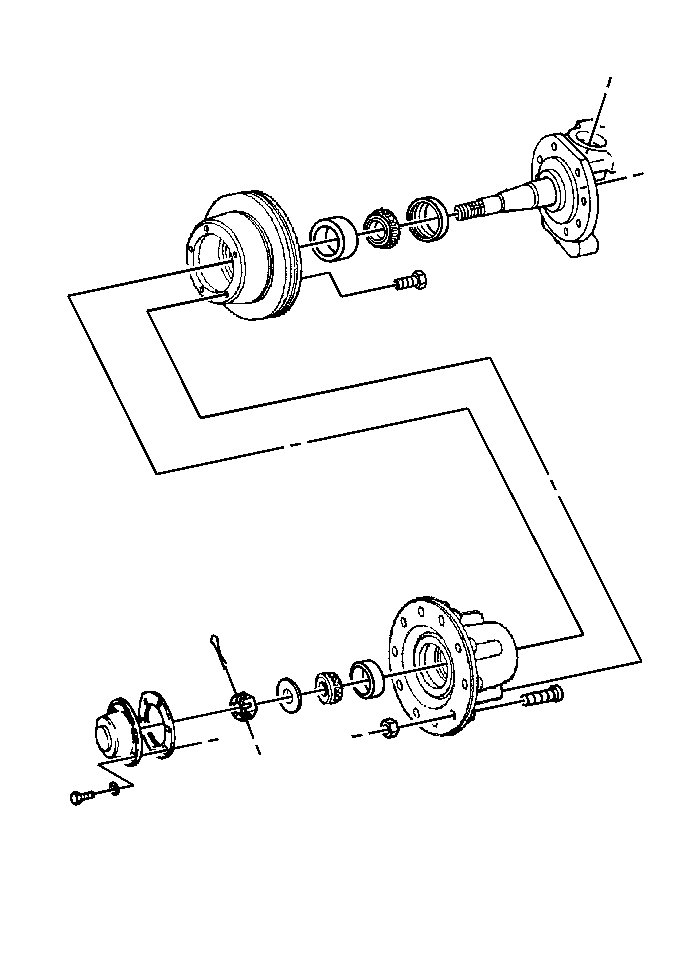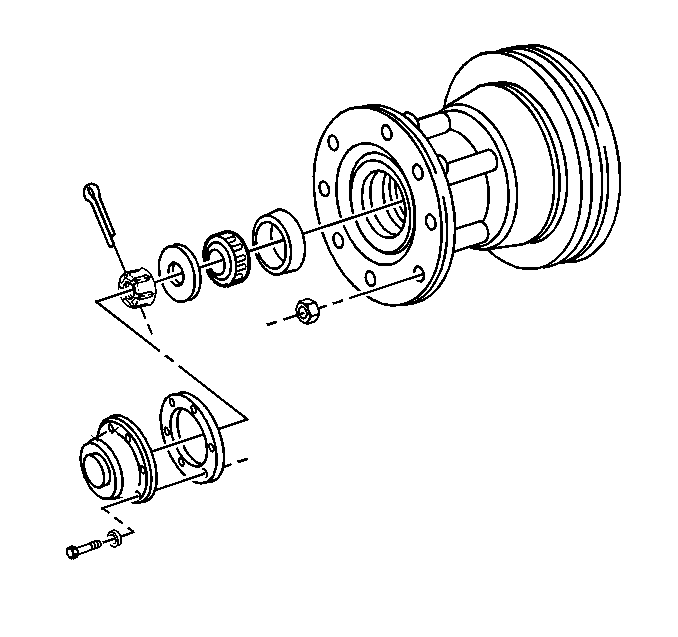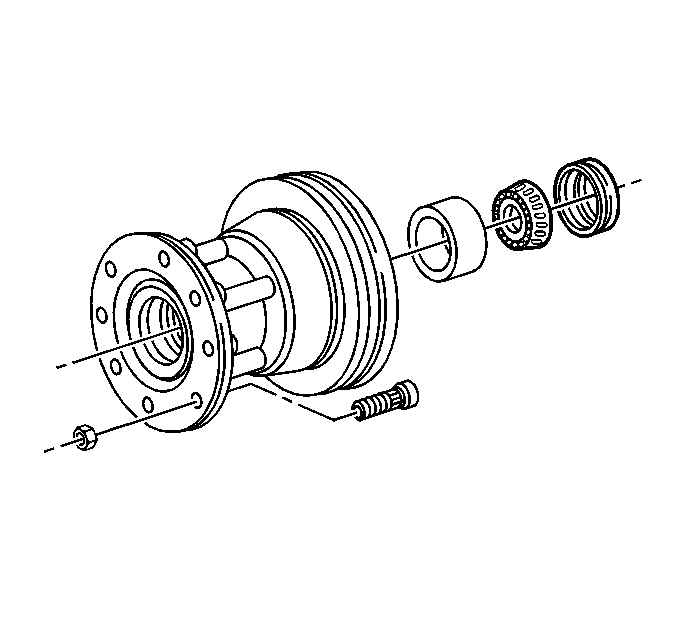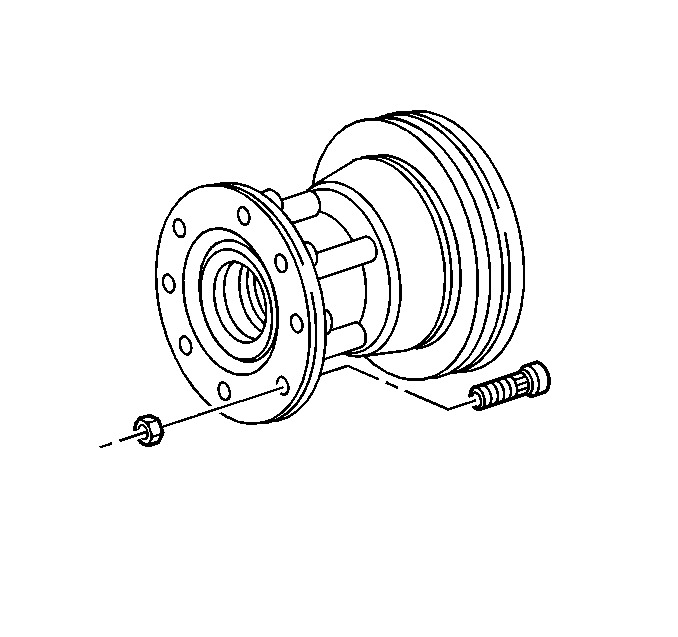Removal Procedure
- Set the parking brake.
- Block the vehicle rear wheels.
- Lift the vehicle frame until the front tire is off the ground.
- Support the frame using suitable safety stands.
- Remove the front tire and wheel assembly. Refer to Wheel Removal .
- Remove the caliper assembly. Refer to Brake Caliper Replacement .
- Remove the hub cap and the gasket.
- Remove the following components:
- Pull the hub and rotor assembly part way off of the spindle of the steering knuckle. Remove the outer wheel bearing.
- Remove the hub and rotor assembly straight off the spindle.
- Remove the seal.
- Remove the inner wheel bearing.
- Remove the bearing cups.
- Remove the brake rotor by removing the hub-to-rotor bolts. Refer to Brake Rotor Replacement .
- Remove the wheel studs, if needed, using a press.

| • | The cotter pin |
| • | The adjusting nut |
| • | The washer |


Notice: Use care to prevent damage to the spindle.
| 13.1. | Insert a mild steel rod through the opposite end of the hub. Drive the rod against the inner edge of the cups. |
| 13.2. | In order to avoid cocking the cups and damaging the inside of the hub, alternately drive the rod on opposite sides of the cups. |

CAUTION:: If one stud is damaged, replace all the studs. A loose-running wheel may cause only one stud to break, but the other studs could have internal fatigue. Replacing only the broken stud and remounting the wheel may cause further damage and personal injury. If the stud holes in the wheels have become enlarged or distorted, replace the wheel.
Inspection Procedure
- Clean the bearings in a suitable solvent. Use a stiff brush in order to remove all of the old lubricant.
- Clean inside the hub and the disc assembly. Thoroughly clean all of the lubricant out of the inside of the hub. Wipe dry.
- Remove all of the gasket particles from the hub outer end. Clean all of the sealing compound out of the oil seal bore in the hub inner end.
- Clean the steering knuckle spindle. Remove all lubricant with a cloth which has been soaked in solvent.
- Clean the cap in solvent. Blow dry. Remove all traces of the old gasket.
- Clean the adjusting nut and the washer in solvent. Blow dry.
- Clean the spindle shoulder and the hub bore. Remove all burrs and sharp edges with an emery cloth. Wipe clean with solvent.
- Inspect the bearing cups for cracks and pits. Replace any cups that are cracked or pitted.
- Inspect the cup fit in the hub. If the cups are loose or if the cups can be rotated in the bore, replace the hub.
- Inspect the bearings for excessive wear, chipped edges, and other damage. Refer to Wheel Bearings Diagnosis .
- Inspect the brake rotor. Refer to Brake Pad Inspection .
- Inspect the wheel studs for cracks or damaged threads.

Caution: When servicing wheel brake parts, do not create dust by grinding or sanding brake linings or by cleaning wheel bearing parts with compressed air. Many wheel brake parts contain fibers that can become air borne if dust is created during servicing. Breathing dust containing fibers may cause serious bodily harm. A water dampened cloth or water based solution should be used to remove any dust on brake parts. Equipment is commercially available to perform this washing function. These wet methods will prevent fibers from becoming airborne.
NOTICE: Do not spin dry the bearings. Spinning the bearings without lubricant will damage them.
NOTICE: Do not use gasoline, kerosene or any other oil base solvents. These solvents may leave an oily residue on the surface which damages the brake linings and is flammable.
Important: Keep the lubricant off of the disc friction surface. Remove the lubricant with a suitable non-toxic, greaseless type of solvent. Wipe the surface clean with clean cloths.
Installation Procedure
- Install the wheel studs, if needed, using a press. Fit the studs tightly.
- Install the brake rotor. Refer to Brake Rotor Replacement .
- Install the bearing cups to the hub. Position each cup in the hub and drive the cup into place using a suitable driver or a brass drift against the outer edge of the cup. If you use a drift, alternately drive against the opposite side in order to drive the cup squarely. Cups must seat against the shoulder in the hub.
- Install the wheel bearings.

Grease Lubricated Wheel Bearing Installation
- Pack the bearings with high-temperature wheel bearing grease.
- Install the inner bearing to the hub.
- Apply grease to the lips of the new seal.
- Apply a thin layer of non-hardening sealing compound to the hub seal bore.
- Install the new seal to the hub. Press the seal into the hub until the seal seats against the bearing cup.
- Install the hub and the disc assembly to the spindle. DO NOT damage the seal or the flange ring.
- Install the outer wheel bearing.
- Install the washer.
- Install the adjusting nut. DO NOT tighten the nut.
- Install the caliper assembly, if equipped. Refer to Brake Caliper Replacement .
- Install the front tire and wheel assembly. Refer to Wheel Installation .
- Adjust the front wheel bearings. Refer to Wheel Bearing Adjustment .
- Install a new gasket. Install the hub cap.
- Install the washers (2) and the bolts (1).
- Lower the vehicle.
- Remove the blocks.
Important:
• Whenever grease is indicated in this procedure, refer to
Fluid and Lubricant Recommendations
in
Maintenance and Lubrication. • Use a greasing machine, if available. If a greasing machine is
not available, pack the bearings by hand. Thoroughly work the grease into
the bearings, between the rollers, the core, and the cage. • Apply a thin coat of grease to the inside of the hub and the spindle.
DO NOT fill the hub with grease. A thin coat of grease 3 mm (1/8 in)
thick will help to retard rusting. Allow some excess grease at the inside
of the bearings and around the adjusting nut.

Important: Face the seal lip inside the hub. Provide enough clearance between the seal and the bearing so that the bearing can rotate freely without rubbing against the seal.
Notice: Use the correct fastener in the correct location. Replacement fasteners must be the correct part number for that application. Fasteners requiring replacement or fasteners requiring the use of thread locking compound or sealant are identified in the service procedure. Do not use paints, lubricants, or corrosion inhibitors on fasteners or fastener joint surfaces unless specified. These coatings affect fastener torque and joint clamping force and may damage the fastener. Use the correct tightening sequence and specifications when installing fasteners in order to avoid damage to parts and systems.
Tighten
Tighten the hub cap bolt evenly to 13 N·m (115 lb in).
